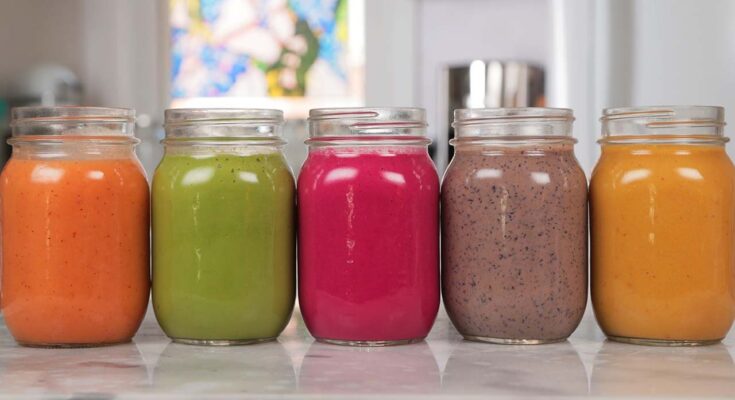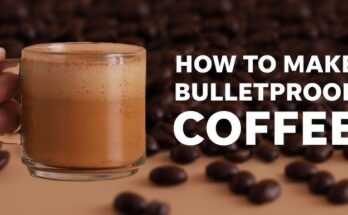Breakfast Smoothie Recipe: There’s nothing quite like a cold, creamy smoothie to kickstart your morning. Whether you’re always on the go or simply want a healthier start to your day, breakfast smoothies are a powerhouse of energy and nutrients.
This guide will walk you through everything you need to know to make the perfect breakfast smoothie, from ingredients to preparation tips.
Why Start Your Day with a Smoothie?
Nutritional Benefits of Breakfast Smoothies
Smoothies pack a punch when it comes to nutrition. You can blend multiple food groups—fruits, vegetables, dairy or non-dairy, protein, and even grains—into one delicious drink. This means you’re starting your day with a diverse array of vitamins, minerals, antioxidants, and fiber. A banana-strawberry smoothie with a handful of spinach and a spoonful of flaxseed, for example, provides potassium, Vitamin C, iron, omega-3s, and more in just one glass.
Another benefit? Smoothies can help balance your blood sugar and keep you feeling full. Unlike sugary cereals or pastries that spike your glucose, smoothies offer steady energy when made with the right ingredients. Want a glowing skin, strong immune system, and a healthy gut? Regular morning smoothies can help with that too.
Time-Saving and Convenient
We get it—mornings are hectic. From rushing to work to handling kids, breakfast often takes a backseat. That’s where smoothies shine. They’re quick to prepare, easy to clean up, and totally portable. Toss the ingredients into a blender, hit a button, and boom—you’ve got breakfast in under 5 minutes.
Plus, with smoothie prep hacks (like freezing pre-measured ingredients in bags), you can make mornings even easier. Imagine reaching into your freezer, grabbing a smoothie pack, and having breakfast ready in minutes. It’s that simple.
Essential Ingredients for a Healthy Breakfast Smoothie
Fruits to Use
Fruits are the stars of the smoothie world. They add natural sweetness, vibrant color, and loads of nutrition. Bananas, berries (blueberries, strawberries, raspberries), mangoes, and pineapples are the go-to choices. Not only do they taste amazing, but they also blend well and create a smooth texture.
Bananas provide creaminess and are rich in potassium and fiber. Berries are loaded with antioxidants and Vitamin C. Mangoes bring tropical sweetness, while apples and pears can add crunch and fiber when blended properly. Don’t be afraid to mix and match!
Frozen fruits work just as well as fresh ones—and they give your smoothie a thicker, milkshake-like consistency without the need for ice.
Protein Sources
If you want your smoothie to keep you full until lunch, protein is a must. Some of the best sources include:
- Greek yogurt (plain or flavored)
- Protein powders (whey, pea, hemp, soy)
- Nut butters (peanut, almond, cashew)
- Chia seeds, hemp seeds, or flaxseeds
- Silken tofu
Adding protein not only helps with satiety but also supports muscle repair and metabolism. For a dairy-free option, go with nut butters or plant-based protein powders.
Liquids and Bases
Your choice of liquid can make or break the smoothie. It determines both flavor and texture. Some common options:
- Water (for a lighter smoothie)
- Milk (dairy or non-dairy like almond, oat, soy, coconut)
- Coconut water (hydrating and slightly sweet)
- Cold brewed tea or coffee (adds a caffeine kick)
- Fruit juice (use sparingly due to high sugar content)
Start with about ½ to 1 cup of liquid and adjust based on how thick or thin you want it.
Superfoods and Boosters
Want to take your smoothie from healthy to supercharged? Add boosters like:
- Spinach or kale (tons of vitamins without changing the taste much)
- Avocado (for healthy fats and creaminess)
- Spirulina or chlorella (great for detoxing)
- Maca powder (energy and hormone balance)
- Cacao nibs or powder (antioxidants + chocolate flavor)
- Oats or quinoa flakes (added fiber and texture)
Don’t overdo it—just 1-2 teaspoons of any booster is enough to power-up your morning.
Equipment You’ll Need
Best Blenders for Smoothies
The blender is the real MVP when it comes to smoothies. High-powered blenders like Vitamix or Blendtec create silky-smooth textures and can even handle frozen ingredients or nuts without a hitch. But you don’t need to splurge right away—there are also great budget-friendly options like the NutriBullet, Ninja, or Hamilton Beach.
Key things to look for:
- A strong motor (at least 600 watts)
- Durable blades
- Ease of cleaning
- Multiple speed options
Optional Tools and Accessories
While not essential, a few extras can elevate your smoothie game:
- Mason jars or reusable smoothie cups
- Silicone straws or wide-mouth metal straws
- Freezer bags for smoothie prep
- Measuring cups and spoons
- A spatula to scrape the blender clean
Now that you’re prepped with all the right tools and ingredients, let’s get into the actual steps of making your smoothie.
Step-by-Step Guide to Making a Breakfast Smoothie
Step 1: Choose Your Fruit
Pick your base fruits. A banana is usually a good start because it adds creaminess and natural sweetness. Add a handful of berries or a few chunks of mango for a burst of flavor and color. You can use fresh or frozen fruit, but frozen is often better for texture and convenience.
Pro Tip: Use overripe bananas—they blend better and are sweeter.
Step 2: Pick Your Liquid Base
Add ½ to 1 cup of liquid depending on how thick you like your smoothies. If you’re going for creamy, try almond milk or oat milk. Want something lighter? Use coconut water or even plain water. Avoid sugary juices unless it’s 100% natural.
Step 3: Add Protein and Superfoods
Here’s where your smoothie transforms from just tasty to truly filling and energizing. Protein keeps hunger pangs away and helps with muscle maintenance. Toss in a scoop of protein powder—whether it’s plant-based, whey, or collagen—or go natural with a few tablespoons of Greek yogurt or nut butter.
Want to add an extra health kick? Sprinkle in some superfoods. Chia seeds, hemp hearts, flaxseeds, or even a teaspoon of spirulina can boost your smoothie’s nutritional profile big time. For a creamier, thicker blend, try adding half an avocado or a spoonful of oats.
Just remember: moderation is key. Too many add-ins can overpower the flavor or mess with the texture.
Step 4: Blend It Right
Now, it’s time to work some blender magic. Start on a low setting to break down the larger chunks of fruit or frozen items. Then gradually increase to high speed until everything is smooth and creamy. Most smoothies only need about 45–60 seconds of blending.
If your smoothie’s too thick? Add a bit more liquid. Too thin? Throw in more fruit or a handful of ice cubes.
And don’t forget to scrape down the sides of the blender with a spatula if you notice anything sticking. You want a nice, uniform blend with no clumps or chunks.
Pro Tip: If your blender struggles with frozen fruits or ice, let them sit out for a couple of minutes before blending, or pulse them a few times before going full blast.
Step 5: Pour and Enjoy
Pour your smoothie into your favorite glass or to-go cup and sip away. If you’re feeling fancy, top it with extra fruit slices, a sprinkle of seeds, granola, or even a drizzle of nut butter. It adds texture, flavor, and style.
Smoothies are best enjoyed fresh, but if you’re in a rush, they can be stored in an airtight container in the fridge for up to 24 hours. Just give it a good shake or stir before drinking, as ingredients may settle or separate over time.
This is your time to enjoy the fruits of your labor—literally. Take a moment, breathe, and savor the healthy start to your day.
FAQs about Breakfast Smoothie Recipe
1. Can I make breakfast smoothies the night before?
Yes! You can prep your smoothie the night before and store it in the fridge in a sealed jar or bottle. Just shake or stir it before drinking.
2. What’s the best fruit combination for a breakfast smoothie?
Banana, mixed berries, and spinach is a classic combo—sweet, balanced, and nutrient-rich. Feel free to experiment with mango, pineapple, or apple too.
3. How can I make my smoothie thicker?
Use frozen fruit, Greek yogurt, oats, or avocado. These ingredients help create a creamy, thick texture without needing ice cream.
4. Is it okay to add vegetables to breakfast smoothies?
Absolutely. Spinach, kale, zucchini, and even cauliflower blend well with fruits and boost the vitamin and fiber content.
5. What’s the ideal portion size for a breakfast smoothie?
Typically, 12–16 ounces is enough to satisfy without overloading. Adjust based on your hunger level and dietary needs.
Conclusion
Smoothies are the ultimate breakfast hero—fast, flavorful, and endlessly customizable. With just a few ingredients and the right technique, you can blend up a delicious, nutrient-packed meal that fuels your body and mind. Whether you’re a seasoned smoothie lover or just starting out, this step-by-step guide gives you everything you need to create your perfect morning blend. So, grab your blender, pick your ingredients, and start sipping your way to better mornings.



